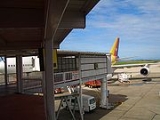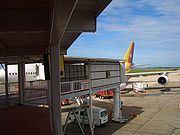
Transport in Fiji
Encyclopedia
Railways
- Main article: Rail transport in FijiRail transport in FijiRail transport in Fiji exists to move cut sugar cane to crushing mills. There used to be two horse-drawn street tramway systems, some other passenger systems, an underground mine system and some tramways on construction projects.- Cane Trains :...
.
Total: 597 km; 597 km 0.610-m gauge (1995)
Narrow gauge: Note: belongs to the government-owned Fiji Sugar Corporation
Fiji Sugar Corporation
Fiji Sugar Corporation is the Government-owned sugar milling company in Fiji having the monopoly on production of all raw sugar in Fiji. It is also the largest public enterprise in Fiji directly employing nearly 3000 people while another 200,000 or more depend on it for their livelihood in rural...
The railway is not for passenger or public use.
Merchant marine
Total: 6 ships (1,000 GRT or over) totaling 11,870 GRT/Ships by type: chemical tanker
Tanker (ship)
A tanker is a ship designed to transport liquids in bulk. Major types of tankship include the oil tanker, the chemical tanker, and the liquefied natural gas carrier.-Background:...
2, passenger 1, petroleum tanker 1, roll-on/roll-off 1, specialized tanker 1 (1999 est.)
Airports

- Main article: List of airports in Fiji.
Major airports include:
- Nadi International AirportNadi International AirportNadi International Airport is the main international gateway for the islands of Fiji. It serves about 1.2 million people per year, and is the main hub of Air Pacific. The airport is 10km from the city of Nadi. In 2009 it handled 1,220,000 passengers on international and domestic...
- Nausori International AirportNausori International AirportNausori International Airport . Also known as Luvuluvu, Nausori Airport is the second International Airport in Fiji. It is situated in Nausori on the south-Eastern side of Viti Levu...
Total 25 (1999 est.)
Airports with paved runways
Total: 3Over 3,047 m: 1
1,524 to 2,437 m: 1
914 to 1,523 m: 1 (1999 est.)

